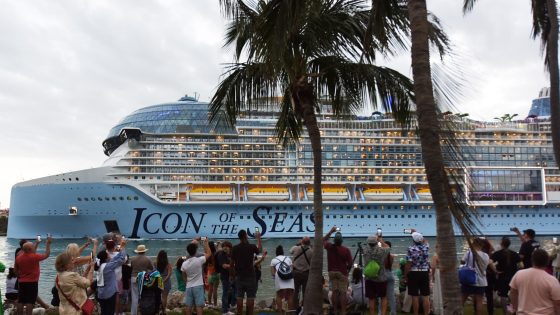Cruise operators have been enjoying strong demand since climbing out of the Covid pandemic, which may have some investors wondering if the good times will last. UBS believes they will. For one, the gap between cruise prices and land-based hotel prices is still “meaningfully wider” than it was in 2019, UBS analyst Robin Farley wrote in a note Monday. “While the cruise lines will always have a gap to hotel pricing, because there is no business travel in the cruise sector to support pricing, there is no fundamental reason why that gap should be significantly wider in 2024 than it was in 2019, especially because the growth in US hotel rate has been driven by leisure demand,” she said. Through the first quarter of this year, the U.S. hotel rate was up over 20% compared with 2019, Farley noted. While cruise lines have seen strong year-over-year demand, per diems â which is how cruises measure the berth pricing per day, including onboard revenue â lag that of hotel rates. Royal Caribbean saw a 16% per diem increase in 2023 from 2019, Norwegian Cruise Line was up 6%, Carnival rose 6% and Viking ‘s per diems gained 17%, she said. Viking just went public on May 1. On top of that, cruises are benefiting from retiring baby boomers who are looking to spend more time traveling and millennials who are starting to hit cruising age, Farley said. The trend began before the pandemic, accelerating ticket prices, and still continues, she added. “Cruise demand is also tied to a broader consumer desire for accumulating experiences rather than objects,” Farley wrote. “We believe that same dynamic will continue to benefit cruise demand, as hotels have already seen leisure travel grow past pre-pandemic levels.” In fact, the industry is attracting new passengers in addition to benefiting from repeat customers, she said. For instance, Carnival’s new-to-cruise passengers jumped more than 20% in the first quarter, he pointed out. “We can see that 2024 is not just benefiting from pent up demand, because that is completely new demand,” Farley said. Melius Research is also bullish on the industry’s future and believes cruise lines are set for continued margin expansion over the next several years. “Demand for cruise has roared back since early ’23 and pricing has followed. There has been concern around the sustainability of the pricing gains, but every quarter demand / pricing accelerates,” analyst Conor Cunningham wrote in a note May 28. “Cruise lines are now just catching hotels on price growth vs. ’19 and have further upside as they look to close the gap to land-based vacations (historically 15% discount vs. 30% today).” Meanwhile, Morgan Stanley’s channel checks show bookings continue to normalize partly due to low remaining inventory and “belt tightening” by consumers. However, cruise pricing is holding up, analyst Jamie Rollo said in a note Friday. The firm met with management of Carnival, Royal Caribbean and Norwegian recently and the feedback was “positive across the board,” he said. Who will benefit Royal Caribbean is the top pick of UBS’ Farley, who has a buy rating on the stock. Her $168 price target on the stock suggests about 9% upside from Friday’s close. “RCL’s Wave season has been the strongest on company record from a volume and price perspective,” she wrote. “RCL is in a record booked position with 2024 rates further ahead of 2023 than they were at the start of the year.” In April, the cruise operator posted an earnings beat for its first quarter and raised its full-year earnings-per-share guidance. “The consumer is doing exceptionally well. Demand is very strong, and it’s accelerating,” CEO Jason Liberty told CNBC in April after the earnings report. The company’s management told Morgan Stanley during their recent meeting that the strong demand is driven by structural growth in travel, as well as spending from its higher-income passengers and the cruise’s value gap to land, which is at about 25% to 30% compared with the 15% gap pre-Covid. “Demographics are encouraging, with half of the company’s guests now millennials, its new-to-cruise share ahead of pre-Covid levels, and repeat rebooking rates twice what they were in the past,” Rollo wrote. “The growth of its private island destination capacity and technology improvements look set to add incremental benefits over multiple years, which the company sees as structural advantages.” Rollo has an equal-weight rating on the stock, although it is his relative preference in the industry. Meanwhile, Farley also has a buy rating on Carnival. Her $21 price target implies about 26% upside from Friday’s close. She believes the stock will benefit from Celebration Cay, a private island that is set to open in summer 2025. The cruise line’s management told Morgan Stanley it sees ongoing demand from the 20% to 45% value gap versus land-based vacations. Its private islands currently receive as many guests as all of its competitors combined and it expects another 4 million when Celebration Cay becomes fully operational, said Rollo, who is underweight Carnival. “CCL’s brands are seeing customers travel less frequently, but spending more when they do (for example, taking one cruise and travelling in a suite, rather than two trips in balcony cabins),” he wrote. Another name on Farley’s buy list is Viking. She believes it should benefit from travel demand from the higher-end consumer. Her price target of $35 suggests 11% upside from Friday’s close. Lastly, Farley is neutral on Norwegian. She expects the cruise line should benefit from a strong demand environment but said it still has balance sheet and execution challenges. Earlier this month, the cruise operator lifted its full-year earnings forecast, citing strong demand and an improved outlook for the year. In the meeting with Morgan Stanley, executives expressed confidence that Norwegian can achieve $300 million in savings.
Source Agencies


